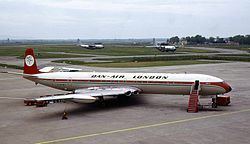Passengers 105 Survivors 0 Operator Dan-Air Survivor 0 | Crew 7 Date 3 July 1970 Total fatalities 112 (all) Passenger count 105 | |
 | ||
Aircraft type de Havilland DH 106 Comet series 4 Registration British civil registration G-APDN Similar Dominicana Flight 603, LANSA Flight 502, Swissair Flight 330, Dan‑Air Flight 1008, Air Canada Flight 621 | ||
Dan-Air Flight 1903 was a de Havilland Comet 4 aircraft operated by Dan Air Services Limited that, on Friday, 3 July 1970, crashed into the wooded slopes of the Serralada del Montseny near Arbúcies (Girona), Catalonia in northern Spain. The flight was on a non-scheduled international passenger service from Manchester to Barcelona. British tour operator Clarksons Holidays had contracted the aircraft to carry a group of holidaymakers who had booked an all-inclusive package holiday with it. The crash resulted in the aircraft's destruction and the deaths of all 112 on board. It was the deadliest aviation accident in 1970, and remains the worldwide deadliest involving a de Havilland Comet.
Contents
The crash was Dan-Air's first fatal accident killing fare-paying passengers. News of the first major accident in the company's eighteenth year of existence came just two days after British tour operator Global Holidays had awarded it a four-year, £2.5 million contract for all Global charter flights from Birmingham, starting in April 1971.
The aircraft
The aircraft, operated by Dan Air Services Ltd, was a de Havilland DH 106 Comet series 4 (registration: G-APDN, construction/manufacturer's serial number: 6415) that had its first flight in 1959. Dan-Air acquired the aircraft from British Overseas Airways Corporation – its original operator – in 1969. At the time of the accident it had flown 25,786 hours.
Accident
Flight 1903, which had departed Manchester at 16:08 local time, encountered air traffic control (ATC) delays in the Paris area, resulting in a change of route. Radio contact between the pilot flying the aircraft and Barcelona Area Control Centre (ACC) was established at 17:53 local time, following which ACC gave the flightdeck crew clearance to descend from 22,000 feet (6,700 m) to 9,000 ft (2,700 m). Six minutes later, the flight was handed over to Barcelona ATC (approach control), and acknowledged that Runway 25 was in use at Barcelona Airport. Approach control cleared the crew to overfly the Sabadell non-directional beacon (NDB) 14 miles (23 km) to the north of Barcelona VOR and descend further to 6,000 feet (1,800 m). This involved turning left to a heading of approximately 140 degrees to intercept the extended centreline of runway 25 at 12 miles (19 km).
While carrying out the left turn as instructed, the crew reported in error that they had passed the Sabadell NDB. In fact they were still 28 nautical miles north of Sabadell at the time, over the Serralada del Montseny, a mountain range in which the highest peaks rise to over 5,600 ft (1,700 m). As, according to ATC, another aircraft overflew Sabadell at the same time, Barcelona ATC mistook that second aircraft's radar echo for that of the Dan-Air Comet and so the air traffic controller handling the Dan-Air flight did not notice the navigational error by the Comet's crew. However, there is no proof that another aircraft overflew the Sabadell beacon at that time. The testament of the air traffic controller remains implausible. Due to lack of evidence to the contrary, the controller cleared the Dan-Air crew to continue their descent to 2,800 ft (850 m). At approximately 18:05 local time, the aircraft crashed into a group of beech trees on the north-east slopes of the Les Agudes peak at an altitude of about 3,800 ft (1,200 m). At the time of the accident, Les Agudes was under half cloud cover at 2,500 ft (760 m) with good visibility below. The explosion following the impact completely destroyed the aircraft and instantly killed everyone on board. The crash site was located 23 miles (37 km) from Sabadell on a bearing of 45 degrees, where the mountains reach a height of 5,100 ft (1,600 m). After an extensive all-night search over a wide area, rescue teams reached the crash site the following day. The Spanish authorities insisted on an immediate burial of the dead bodies due to public health reasons.
Cause
The investigation identified a combination of erroneous information, in relation to en-route reporting points and the existence of a radar echo from another aircraft that overflew the Sabadell NDB at the same time as the Dan-Air crew mistakenly reported passing it, as the accident's probable cause. This combination resulted in an involuntary error on the part of both ATC and aircraft that could not be corrected by the time the air traffic controller realized that his instructions to the aircraft's crew were given in response to a mutual misunderstanding, which resulted from a navigational error on the crew's part that had gone unnoticed.
